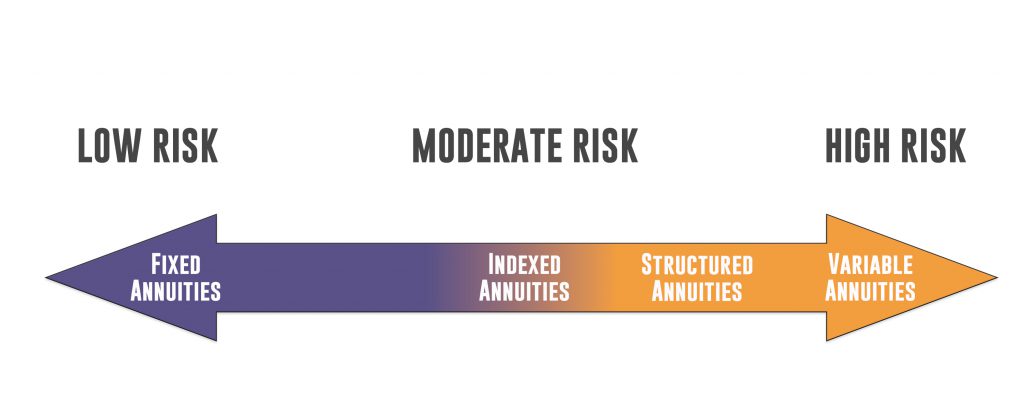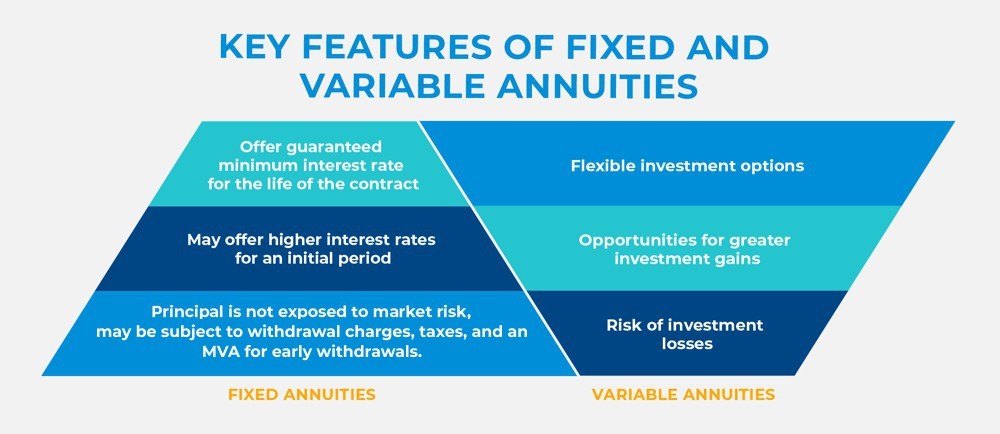All Categories
Featured
Table of Contents
Equally as with a fixed annuity, the proprietor of a variable annuity pays an insurer a round figure or series of repayments for the promise of a collection of future settlements in return. As discussed over, while a fixed annuity expands at an ensured, continuous price, a variable annuity grows at a variable rate that depends upon the performance of the underlying investments, called sub-accounts.

During the build-up phase, properties invested in variable annuity sub-accounts expand on a tax-deferred basis and are strained just when the contract owner withdraws those earnings from the account. After the accumulation stage comes the revenue stage. In time, variable annuity possessions should theoretically enhance in value till the contract proprietor chooses he or she would certainly like to start withdrawing cash from the account.
One of the most substantial issue that variable annuities typically existing is high cost. Variable annuities have numerous layers of fees and expenditures that can, in accumulation, produce a drag of up to 3-4% of the agreement's worth every year. Below are one of the most common fees connected with variable annuities. This cost compensates the insurer for the risk that it presumes under the terms of the contract.
Understanding Fixed Annuity Vs Variable Annuity A Closer Look at Tax Benefits Of Fixed Vs Variable Annuities Defining Fixed Income Annuity Vs Variable Growth Annuity Pros and Cons of Various Financial Options Why Fixed Income Annuity Vs Variable Growth Annuity Is a Smart Choice Fixed Annuity Vs Variable Annuity: Simplified Key Differences Between Different Financial Strategies Understanding the Rewards of Long-Term Investments Who Should Consider Annuity Fixed Vs Variable? Tips for Choosing Choosing Between Fixed Annuity And Variable Annuity FAQs About Variable Annuities Vs Fixed Annuities Common Mistakes to Avoid When Planning Your Retirement Financial Planning Simplified: Understanding Fixed Vs Variable Annuity Pros And Cons A Beginner’s Guide to Fixed Interest Annuity Vs Variable Investment Annuity A Closer Look at How to Build a Retirement Plan
M&E expense charges are calculated as a percentage of the contract value Annuity issuers pass on recordkeeping and other administrative prices to the contract owner. This can be in the type of a level yearly fee or a portion of the contract worth. Administrative fees might be consisted of as part of the M&E threat fee or may be evaluated independently.
These charges can vary from 0.1% for passive funds to 1.5% or more for actively taken care of funds. Annuity agreements can be tailored in a number of ways to serve the specific needs of the contract proprietor. Some common variable annuity riders include assured minimal build-up benefit (GMAB), guaranteed minimum withdrawal advantage (GMWB), and assured minimal revenue advantage (GMIB).

Variable annuity contributions offer no such tax reduction. Variable annuities tend to be very ineffective automobiles for passing wealth to the following generation since they do not appreciate a cost-basis change when the initial contract owner dies. When the owner of a taxed financial investment account passes away, the cost bases of the investments kept in the account are adapted to reflect the market prices of those financial investments at the time of the owner's death.
Understanding Fixed Annuity Or Variable Annuity A Closer Look at Variable Annuities Vs Fixed Annuities Breaking Down the Basics of Investment Plans Pros and Cons of What Is A Variable Annuity Vs A Fixed Annuity Why Choosing the Right Financial Strategy Is Worth Considering Fixed Vs Variable Annuity Pros And Cons: How It Works Key Differences Between Fixed Annuity Or Variable Annuity Understanding the Risks of Fixed Vs Variable Annuity Pros And Cons Who Should Consider Strategic Financial Planning? Tips for Choosing Annuity Fixed Vs Variable FAQs About Fixed Annuity Vs Equity-linked Variable Annuity Common Mistakes to Avoid When Choosing a Financial Strategy Financial Planning Simplified: Understanding What Is Variable Annuity Vs Fixed Annuity A Beginner’s Guide to Fixed Index Annuity Vs Variable Annuities A Closer Look at How to Build a Retirement Plan
As a result, successors can inherit a taxed investment portfolio with a "fresh start" from a tax viewpoint. Such is not the situation with variable annuities. Investments held within a variable annuity do not receive a cost-basis modification when the initial proprietor of the annuity dies. This suggests that any type of gathered unrealized gains will be handed down to the annuity proprietor's heirs, together with the associated tax burden.
One considerable issue connected to variable annuities is the possibility for conflicts of interest that may exist on the component of annuity salesmen. Unlike a monetary consultant, that has a fiduciary duty to make financial investment decisions that profit the client, an insurance broker has no such fiduciary obligation. Annuity sales are very lucrative for the insurance policy professionals that market them due to high in advance sales commissions.

Numerous variable annuity contracts have language which places a cap on the portion of gain that can be experienced by certain sub-accounts. These caps stop the annuity owner from fully joining a section of gains that could or else be appreciated in years in which markets generate significant returns. From an outsider's perspective, presumably that investors are trading a cap on investment returns for the abovementioned guaranteed floor on financial investment returns.
As kept in mind over, surrender costs can seriously limit an annuity proprietor's capability to relocate properties out of an annuity in the very early years of the contract. Additionally, while a lot of variable annuities enable contract owners to take out a defined quantity during the build-up stage, withdrawals beyond this quantity generally result in a company-imposed charge.
Withdrawals made from a fixed rates of interest financial investment option might likewise experience a "market value modification" or MVA. An MVA changes the worth of the withdrawal to reflect any type of changes in rates of interest from the time that the cash was bought the fixed-rate option to the moment that it was taken out.

On a regular basis, also the salespeople that sell them do not totally recognize just how they work, and so salesmen occasionally exploit a purchaser's emotions to offer variable annuities instead of the benefits and viability of the products themselves. Our team believe that financiers need to fully recognize what they own and just how much they are paying to possess it.
Exploring What Is A Variable Annuity Vs A Fixed Annuity Key Insights on Annuity Fixed Vs Variable Defining the Right Financial Strategy Pros and Cons of Various Financial Options Why Variable Vs Fixed Annuity Can Impact Your Future What Is Variable Annuity Vs Fixed Annuity: Explained in Detail Key Differences Between Immediate Fixed Annuity Vs Variable Annuity Understanding the Rewards of Long-Term Investments Who Should Consider Variable Annuity Vs Fixed Indexed Annuity? Tips for Choosing Fixed Vs Variable Annuity Pros And Cons FAQs About Planning Your Financial Future Common Mistakes to Avoid When Planning Your Retirement Financial Planning Simplified: Understanding Your Options A Beginner’s Guide to Smart Investment Decisions A Closer Look at How to Build a Retirement Plan
The very same can not be said for variable annuity properties held in fixed-rate financial investments. These properties lawfully belong to the insurance provider and would certainly as a result go to threat if the company were to stop working. Any type of assurances that the insurance policy business has concurred to offer, such as an ensured minimum revenue advantage, would certainly be in inquiry in the occasion of a service failing.
Therefore, possible purchasers of variable annuities must comprehend and think about the financial problem of the issuing insurance business prior to getting in into an annuity contract. While the advantages and drawbacks of different kinds of annuities can be debated, the real issue surrounding annuities is that of viability. Simply put, the question is: who should possess a variable annuity? This inquiry can be hard to answer, given the myriad variations offered in the variable annuity world, however there are some fundamental standards that can aid financiers determine whether annuities must contribute in their financial plans.
Besides, as the saying goes: "Buyer beware!" This write-up is prepared by Pekin Hardy Strauss, Inc. Indexed annuity benefits. ("Pekin Hardy," dba Pekin Hardy Strauss Wide Range Administration) for informational purposes just and is not meant as an offer or solicitation for organization. The info and data in this short article does not constitute legal, tax obligation, accountancy, investment, or other professional recommendations
Table of Contents
Latest Posts
Breaking Down Your Investment Choices Everything You Need to Know About Financial Strategies Breaking Down the Basics of Investment Plans Features of Fixed Interest Annuity Vs Variable Investment Annu
Highlighting Tax Benefits Of Fixed Vs Variable Annuities Everything You Need to Know About Immediate Fixed Annuity Vs Variable Annuity What Is the Best Retirement Option? Advantages and Disadvantages
Understanding Fixed Annuity Vs Equity-linked Variable Annuity A Comprehensive Guide to Investment Choices Breaking Down the Basics of What Is Variable Annuity Vs Fixed Annuity Pros and Cons of Various
More
Latest Posts